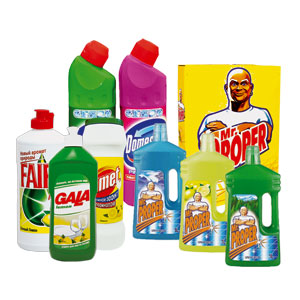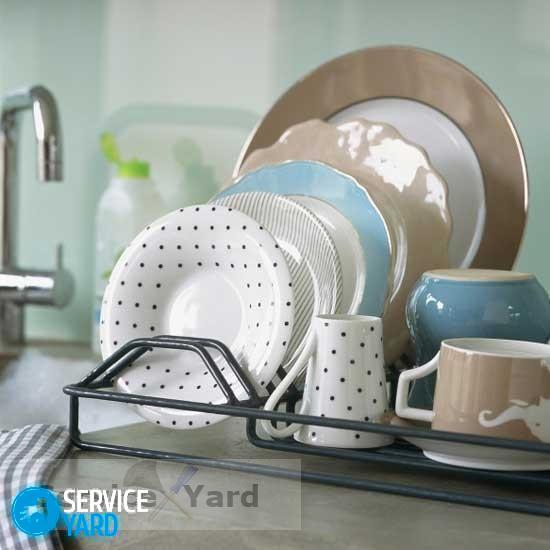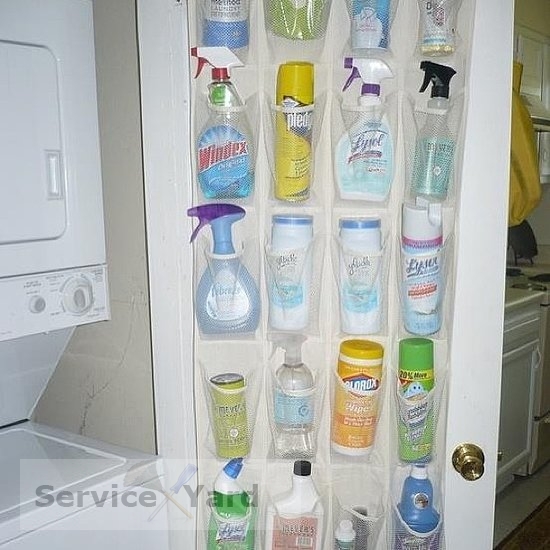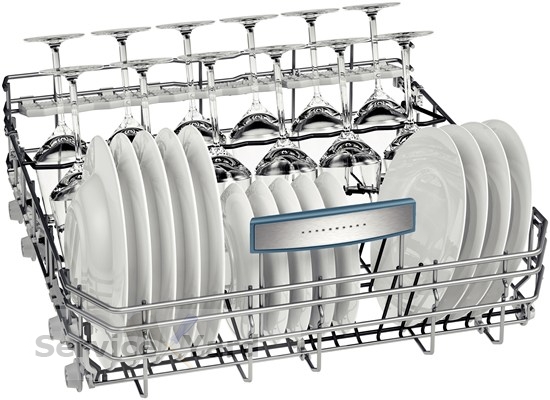Dishwasher Cleaner

The dishwasher saves time and physical effort of housewives when washing dishes, but as the car does not work without gasoline, the dishwasher is useless without detergents, regenerative salt and rinse aid. For an automatic dishwashing machine to serve for a long time, it is necessary not only to use the unit correctly, but also to choose and use the dishwasher detergent correctly.
to contents ↑What tools do you need for a dishwasher?
All dishwashing detergents perform one single function: they wash the utensils well from food debris and remove all impurities. The best and most effective result of washing dishes will be if you use all the necessary detergents in the complex. They are divided into 3 main types:
- Detergent to remove dirt.
- Salt to soften water.
- Rinse aid (to prevent stains and stains on dishes when washing).
Important! In no case should you use dishwashing detergents, as well as ordinary soap and powder in a dishwasher, as they foam more and simply pour out of the machine.
 By type of execution, detergents for the dishwasher are divided into:
By type of execution, detergents for the dishwasher are divided into:
- Powders.
- Pills.
What means to use - it all depends on your preferences and experience. When choosing a dishwasher, be sure to check with sales consultants what types of detergents can be loaded into the appliance.
Consider the advantages and benefits of tablets and powders.
Powder
Powder is the most affordable and popular detergent. For 1 wash cycle, on average, about 25-30 g of powder is consumed. If you purchase 1 kg of products, then it is enough for 35-40 cycles. A measuring spoon is supplied with the package to determine the right amount of powder. Sometimes the packaging indicates the volume of the container lid, which can also be used as a measuring container.
Pills
This product is more convenient to use, as it cannot be accidentally spilled during loading. Pills come in:
- Single-layer (standard tools).
- Layered.
- Multi-layer combined (3 in 1).
Using multilayer combination tablets, you simultaneously load into the dishwasher:
- Detergent components.
- Water softeners that replace regenerative salt.
- Rinse aid.
Many models of modern dishwasher units allow the use of combination tablets, but to verify this, refer to the instructions of the machine.
Important! Manufacturers do not recommend the use of combination products in regions where the water is very hard or very soft.
Different types of tablets and different dissolution rates of the layers differ. The dosage of detergent in tablets depends on the volume of the dishwasher and is indicated in the technical characteristics of the device. The usual consumption is 1 tablet per cycle. If the water is very hard, then the initial dosage should be increased by 1 tablet.
to contents ↑Important! Disadvantages of tablets:
- Detergents for dishwashers in tablets, in terms of 1 wash cycle, are slightly more expensive than detergents in powder.
- Tablets do not have time to dissolve during short programs.Manufacturers of dishwasher units recommend, when using tablets, to choose programs of normal duration.
Detergents for dishwashers
There are other distinctive criteria for the types of dishwasher products. These include the following.
Degree of aggressiveness
 According to the degree of impact on the dishes, means for dishwashers are conditionally divided into 2 groups:
According to the degree of impact on the dishes, means for dishwashers are conditionally divided into 2 groups:
- Strongly alkaline. This product contains caustic alkaline components, such as phosphates, sodium carbonates, silicates, chemical bleaches based on chlorine or oxygen. These drugs are designed to destroy fat and protein contaminants.
- Alkaline detergents. The composition of these products, as a rule, includes enzymes. If the instructions for the detergent indicate the presence of enzymes, then such a cleaner is best suited for washing household items at a water temperature of 45-50 C. It is under this regime that ideal conditions are created for the effective manifestation of the properties of enzymes.
Important! Biological enzymatic additives (enzymes) break down proteins, fats and polysaccharides. The use of enzyme additives facilitates the removal of contaminants based on oils and fats. It is the insoluble proteins, fats and oils that are “eaten” into the dishes if several hours have passed after using the utensils. The use of detergents with enzymes in this case will significantly increase the washing efficiency.
Chemical composition
According to the chemical composition, detergents are divided into 3 main types:
- Containing alkaline components and an oxidizing component based on chlorine. They cope perfectly with any type of pollution: traces of tea, coffee and red wine, but being quite caustic, can change the color of dishes made from synthetic materials. Also, this product is not recommended for washing fragile, thin, metal (aluminum), silver dishes. For this type of utensil, choose a more gentle, soft tool.
- Containing alkaline components and an oxygen-based oxidizing agent. The second group of products is characterized by a milder whitening effect, so they are used for most types of dishes. Detergents containing enzymes and alkaline components, but not containing oxidizing components, have a high-quality detergent effect at low temperatures. This product carefully treats dishes and acts on it sparingly.
- Containing alkaline components, but not containing oxidizing components. In addition to synthetic detergents for dishwashers, products from natural raw materials that completely decompose during washing appeared on the household chemicals market. Such products do not contain aggressive components: phosphates, chlorine, synthetic preservatives, dyes. Instead, they include active natural ingredients and oxygen. The dishes are cleaned with oxygen and natural active ingredients. These products cope well with various contaminants, even at low temperatures, in addition, they are environmentally friendly - both for nature and human health.
Important! When choosing a detergent, carefully study its composition, and also do not forget to clarify what type of dishes it is suitable for washing. If there are no special marks, then do not use this product for fragile crystal and silver. For such utensils, choose the means for dishwashers, on the packaging of which this possibility will be agreed.
Special conditions for using dishwasher detergents
Some dishes require extreme care. Such utensils include:
- Crockery.
- Aluminum objects - this alloy dissolves under the influence of oxidizing agents and alkalis).
- Overglaze painting utensils - can fade, lose color and even disappear).
- Glassware, if there is no symbol on it that can be washed in a dishwasher - otherwise the glass will cloud.
to contents ↑Important! Some types of utensils can be washed in the dishwasher only in a gentle manner. For this type of dishware, choose a delicate program with the lowest temperature and cycle time, and at the end of washing, remove the dishware from the machine as soon as possible. We recommend reducing the dose of detergent for dishwashers by 1.5 times. For example, this type of utensil includes cups and plates with pictures and icing.
Rinse aid for dishwasher
 To completely remove the detergent residues and give the dishes a shine, manufacturers recommend adding a special liquid rinse to the dishwasher. Its distinctive features are as follows:
To completely remove the detergent residues and give the dishes a shine, manufacturers recommend adding a special liquid rinse to the dishwasher. Its distinctive features are as follows:
- The composition of such a product includes nonionic surfactants that effectively wet the surface of the dishes with water and accelerate the drainage of water. As a result, this leads to quick drying and the absence of spots and stains on the surface of the utensil.
- Acids (such as citric acid) that make up the rinse aid remove and neutralize the alkaline components of the detergent used.
- On average, a rinse aid with a volume of 0.5-0.7 liters is enough for 10-12 cycles of washing dishes (3-5 ml for 1 cycle).
- The rinse aid acts on glassware very effectively. Thanks to quick drying, the glass does not tarnish, but remains as clear.
- Rinses are completely washed off during the cycle and are not harmful to human health.
to contents ↑Important! If allergies are present in the family, then we recommend that after washing, restart the dishwasher and select a rinse cycle to completely get rid of any chemical components.
Water softener
To get a quality result when washing dishes, you need to use only soft water, that is, water with a low lime content. Otherwise, a white precipitate appears on the dishes and on the inside of the dishwasher. Information on the water hardness level in the tap can be obtained at the waterworks.
Important! Some manufacturers of dishwashers come with a tester to determine the level of water hardness. This allows you not only to clarify the quality of your water in the tap, but also to find the perfect detergent for the dishwasher.
In areas where water is already soft, softening salt is not necessary, however, in areas where water is very hard, salt is simply necessary. It will not only help reduce the hardness of the water, and therefore - improve the quality of washing, but also extend the life of the dishwasher itself.
In most dishwashers, the capacity for the regenerating salt is quite voluminous, so that 1-2 kg of the product can be loaded immediately. As soon as the salt is finished, the indicator on the control panel lights up. If the water softener is over and there is nothing to add, then use ordinary table salt, but remember that the salt must be large and very clean.
to contents ↑Important! The quality of salt can be checked by dissolving a teaspoon of the product in a glass of water. If the water becomes cloudy, then such salt should not be added to the machine.
Useful Tips:
- Before you put the dishes in the machine, wash off the leftover food with a strong stream of water.
- When choosing standard or combination products for dishwashers, remember that:
- in the first case, you yourself can regulate the flow of funds, depending on the pollution and specific washing conditions;
- in the second, you will constantly spend the “average” dose of the product, which means you cannot save the detergent.
- Be sure to use cleaning agents for the dishwasher itself. Get:
- Degreaser - a means to remove residual fat from the inside of the machine (sold in the form of granular powder or gel).Pour the degreaser or pour it into the same compartment where the dishwasher detergent is placed. It is necessary to use a degreaser after 15-20 cycles of the machine.
- Anti-scale - use for prophylaxis: pour the powder into the box and start the program with a temperature of 40-45 C, without first rinsing. Use a descaler 2-4 times a year, depending on the hardness of the water. The best result is achieved if anti-scale is applied after degreasing.
- Deodorant or freshener. When washing dishes, not only fat accumulates on the surface of the machine, but even bits of food can remain in parts such as a filter and drain. As a result, unpleasant odors appear in the car. The deodorant will eliminate the problem and give a freshly washed dish a light citrus or floral smell.
to contents ↑Important! Detailed instructions for the use of deodorant, degreaser, descaling agent are always contained on the packaging. Before using the products, be sure to study them.
Stock footage
According to experts, dishwasher detergents do not harm human health. Even strongly alkaline products do not come into contact with human hands, therefore they pose no danger to health and skin. Therefore, use the dishwasher for good health. Let your “home assistant” do the dirty work, and spend your free time on your family or favorite hobby.
- How to choose a vacuum cleaner taking into account the characteristics of the house and coatings?
- What to look for when choosing a water delivery
- How to quickly create comfort at home - tips for housewives
- How to choose the perfect TV - useful tips
- What to look for when choosing blinds
- What should be running shoes?
- What useful things can you buy in a hardware store
- Iphone 11 pro max review
- Than iPhone is better than Android smartphones



